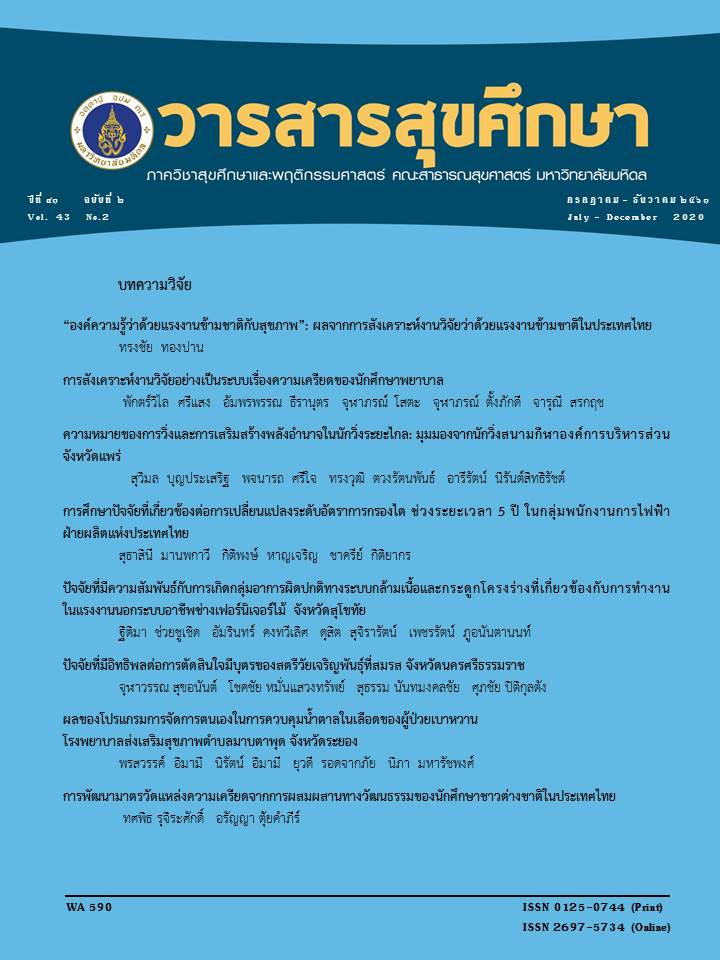Effects of Self-Management Program on Blood Sugar Control of Diabetic Patients at Mabtaphut Sub-district Health Promotion Hospital in Rayong Province
Main Article Content
Abstract
Diabetes is a chronic and severe disease that new cases have been increasing continuously. The decreasing dietary intake is a critical target behaviors to control blood sugar and to reduce long term complications. The objective of this two-group quasi-experimental study was to assess the effects of a self-management program on blood sugar control of diabetic patients of Mabtaphut Sub-district Health Promotion Hospital in Rayong Province. Forty experiment patients were stratified by gender and randomly selected from three consecutive diabetes clinic day. Thus, three small groups were recruited to be voluntary participated in the study program for 12 weeks. The program activities were developed based on a model of self-regulation for controlling the chronic disease by Clark. To maximize internal validity of the study, forty comparable patients regarding gender, age, years of having diabetes, and blood sugar level were selected from the next following diabetes clinic day after the study group was recruited. A self-administered questionnaire collected pretest and posttest data. The data were analyzed by percentage, mean, standard deviation, independent t-test, and Paired sample’s t-test.
Findings affirmed the effects of the program that made the fasting blood sugar (FBS) of the experimental group decreasing from a high level ( =166.10 mg/dl) to controllable level ( =125.93 mg/dl). The significant reduction of FBS (p<0.01) due to having more appropriate dietary behaviors; better-perceived self-efficacy to perform the behaviors; higher perceived outcome expectations to reduce complications; and more self-management practices to control blood sugar than before the experiment and better than the comparison group. Thus, in designing an intervention to modify disease management health behaviors, self-efficacy may use as a starting point of the program features and information required should be relevant to the desired behavioral targets.
Article Details
References
American Diabetes Association. Standards of medical care in diabetes. Diabetes Care. 2017;40(Suppl 1):33-43.
สำนักโรคไม่ติดต่อ กรมควบคุมโรค กระทรวงสาธารณสุข. สถิติผู้ป่วยโรคเบาหวานทั่วโลก [อินเทอร์เน็ต]. 2560. [เข้าถึงเมื่อ 14 เมษายน 2561]; เข้าถึงได้จาก: http://www.thaincd. com/document/info/non-communicable-disease.
วิชัย เอกพลากร. สถานการณ์โรคเบาหวานในประเทศไทย. วารสารเบาหวาน 2560;49(1):7-14.
สำนักงานพัฒนานโยบายสุขภาพระหว่างประเทศ กระทรวงสาธารณสุข. รายงานภาระโรคและการบาดเจ็บของประชากรไทย พ.ศ. 2554. นนทบุรี: มูลนิธิเพื่อพัฒนานโยบายสุขภาพระหว่างประเทศ; 2557. หน้า 6.
ศูนย์ข้อมูลสุขภาพ (HDC) กระทรวงสาธารณสุข. (2561). การป่วยการตายด้วยโรคไม่ติดต่อที่สำคัญ [อินเทอร์เน็ต]. 2561. [เข้าถึงเมื่อ 11 กรกฎาคม 2561]; เข้าถึงได้จาก http:/hdcservice.moph.go.th/hdc/main/index pk.php.
สมาคมโรคเบาหวานแห่งประเทศไทยในพระราชูปถัมภ์สมเด็จพระเทพรัตนราชสุดาฯ สยามบรมราชกุมารี. แนวทางเวชปฏิบัติสำหรับโรคเบาหวาน. ปทุมธานี: บริษัทร่มเย็นมีเดียจำกัด; 2560. หน้า 35, 45.
สมาคมโรคเบาหวานแห่งประเทศไทยในพระราชูปถัมภ์สมเด็จพระเทพรัตนราชสุดาฯ สยามบรมราชกุมารี. แนวทางเวชปฏิบัติสำหรับโรคเบาหวาน. ปทุมธานี: บริษัทร่มเย็นมีเดียจำกัด. 2554. หน้า จ.
สุธีรา บุญแต้ม, มณีรัตน์ ธีระวิวัฒน์ และนิรัตน์ อิมามี. ปัจจัยที่สัมพันธ์กับพฤติกรรมการดูแลตนเองของผู้ที่เป็นเบาหวานชนิดที่ 2 จังหวัดสุพรรณบุรี. วารสารสุขศึกษา 2556;36(123):65-80.
ศุภัชฌา สุดใจ, สุปรียา ตันสกุล, มณีรัตน์ ธีระวิวัฒน์ และนิรัตน์ อิมามี. โปรแกรมส่งเสริมการบริโภคอาหารประยุกต์แบบจำลองข่าวสาร แรงจูงใจและทักษะพฤติกรรมในผู้ป่วยเบาหวาน จังหวัดนนทบุรี. วารสารสุขศึกษา 2559;39(132):35-50.
Green LW & Kreuter MW. Health promotion planning: An educational and ecological approach 3rd Ed. CA: Mayfield; 1999. pp. 113-116.
Green LW, Kreuter MW, Deeds SG, & Partridge KB. Heath education planning: A diagnostic approach. Palo Alto, CA: Mayfield; 1980.
Clark NM, Gong M, & Kaciroti N. A model of self-regulation for control of chronic disease. Health education & behavior 2001;28(6):769-782.
Bandura A. Perceived self-efficacy in cognitive development and functioning. Educational Psychologist 1993;28:117-148.
Cohen J. Statistical power analysis for the behavioral sciences. Second Edition. Hillsdale, NJ: Lawrence Erlbaum Associates, Publishers; 1988.
Cohen J. Quantitative methods in psychology: A power primer. Psychological Bulletin 1992;112(1):155-159.
นิรัตน์ อิมามี. เครื่องมือการวิจัยใน เอกสารประมวลสาระชุดวิชาสถิติและการวิจัยในการจัดการสุขภาพ หน่วยที่ 9. นนทบุรี: มหาวิทยาลัยสุโขทัยธรรมาธิราช; 2554.
วิชัย เทียนถาวร. ระบบการเฝ้าระวังพฤติกรรมสุขภาพเพื่อการปรับเปลี่ยนพฤติกรรมเสี่ยงของกลุ่มปกติ/กลุ่มเสี่ยง/กลุ่มป่วยโรคเบาหวาน ความดันโลหิตสูงในประเทศไทย. กรุงเทพฯ: ชุมชนสหกรณ์การเกษตรแห่งประเทศไทย; 2556. หน้า 20.
สมาคมโรคเบาหวานแห่งประเทศไทยในพระราชูปถัมภ์สมเด็จพระเทพรัตนราชสุดาฯ สยามบรมราชกุมารี. แนวทางเวชปฏิบัติสำหรับโรคเบาหวาน 2560. ปทุมธานี: บริษัทร่มเย็นมีเดียจำกัด; 2560. หน้า 5, 50-58.
Pender NJ, Murdaugh CL, Parsons MA. Health promotion in nursing practice, 5th Ed. NJ: Pearson Education; 2006. pp. 57-59.
สุรีย์พร ปัญญาเลิศ, นิรัตน์ อิมามี และวรากร เกรียงไกรศักดา. การกำกับตนเองในการส่งเสริมพฤติกรรมการบริโภคอาหารและการออกกำลังกายของผู้ป่วยเบาหวาน จังหวัดสุพรรณบุรี. วารสารสุขศึกษา 2560;40(1):69-81.
อรวรรณ มุงวงษา, มณีรัตน์ ธีระวิวัฒน์, สุปรียา ตันสกุล และนิรัตน์ อิมามี. โปรแกรมการรับรู้ความสามารถตนเองในการบริโภคอาหารเพื่อควบคุมระดับน้ำตาลในเลือดของผู้ป่วยเบาหวานชนิดที่ 2 จังหวัดนครปฐม. วารสารกรมการแพทย์ 2560;42(5):62-70.
อุมาลี ธรศรี, พัชราณี ภวัตกุล, มณีรัตน์ ธีระวิวัฒน์ และกานดาวสี มาลีวงษ์. โปรแกรมส่งเสริมโภชนาการ: ลดหวาน มัน เค็ม ประยุกต์การกำกับตนเองและแรงสนับสนุนจากครอบครัวในผู้ป่วยโรคเบาหวานชนิดที่ 2. วารสารสาธารณสุขศาสตร์ 2561;48(3):284-295.


